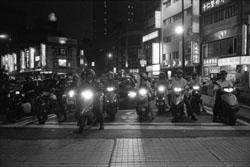

 Mauro Restiffe is not exactly what one would call an objective photographer, although one of the first impressions one usually has of his photos is their innate visual authority. Printed in black-and-white, sometimes at an imposing scale, the images themselves tend to be of fairly ordinary subjects. The photos might contain people, or some easily discernible action, or they just as easily might not. And even in those photographs where something momentous has taken place – his Brasilia series, for example, was photographed the day of President Lula’s inauguration – either the focus of everybody’s attention is elsewhere, or else the key event that ties everything together and gives each player a purpose, has already come and gone. Even in his photographs of places, such as Istanbul, that some might refer to as exotic, Restiffe seems primarily engaged in the close-up, the nondescript corner, or the random event than he is feeding into the viewer’s feelings of otherness.
Mauro Restiffe is not exactly what one would call an objective photographer, although one of the first impressions one usually has of his photos is their innate visual authority. Printed in black-and-white, sometimes at an imposing scale, the images themselves tend to be of fairly ordinary subjects. The photos might contain people, or some easily discernible action, or they just as easily might not. And even in those photographs where something momentous has taken place – his Brasilia series, for example, was photographed the day of President Lula’s inauguration – either the focus of everybody’s attention is elsewhere, or else the key event that ties everything together and gives each player a purpose, has already come and gone. Even in his photographs of places, such as Istanbul, that some might refer to as exotic, Restiffe seems primarily engaged in the close-up, the nondescript corner, or the random event than he is feeding into the viewer’s feelings of otherness.
In a sense, Restiffe’s images are visual transcriptions of a place that is neither the one we are occupying, nor someplace else. It is a kind of in-between experience of daily life, in which events and people seem to hover between their quotidian meanings and something quite profound. Infused with a sense of mortality, but never so sober as to appear grim, in the final analysis Restiffe’s photographs seem to be as much about our act of searching for meaning as they are about his act of pressing the shutter.
Red Light Portraits is the name Restiffe has given to a new body of work created especially for Taipei. Visiting the city for the first time earlier in 2006, the artist literally spent days combing the streets of the city, wondering what his subject would be. After a time, he discovered he was drawn repeatedly to the same subject: formations of motorcyclists idling as they wait for the traffic light to change color. Of course these are not exactly portraits, since probably only the people in the photographs would actually recognize themselves, but the series does function as a kind of composite portrait of the city of Taipei. Balanced precariously between its past and future, between the outward signs of social decorum, and the individual and collective passions of its inhabitants, the city waits as if for a signal, ready to move forward on a moment’s notice.